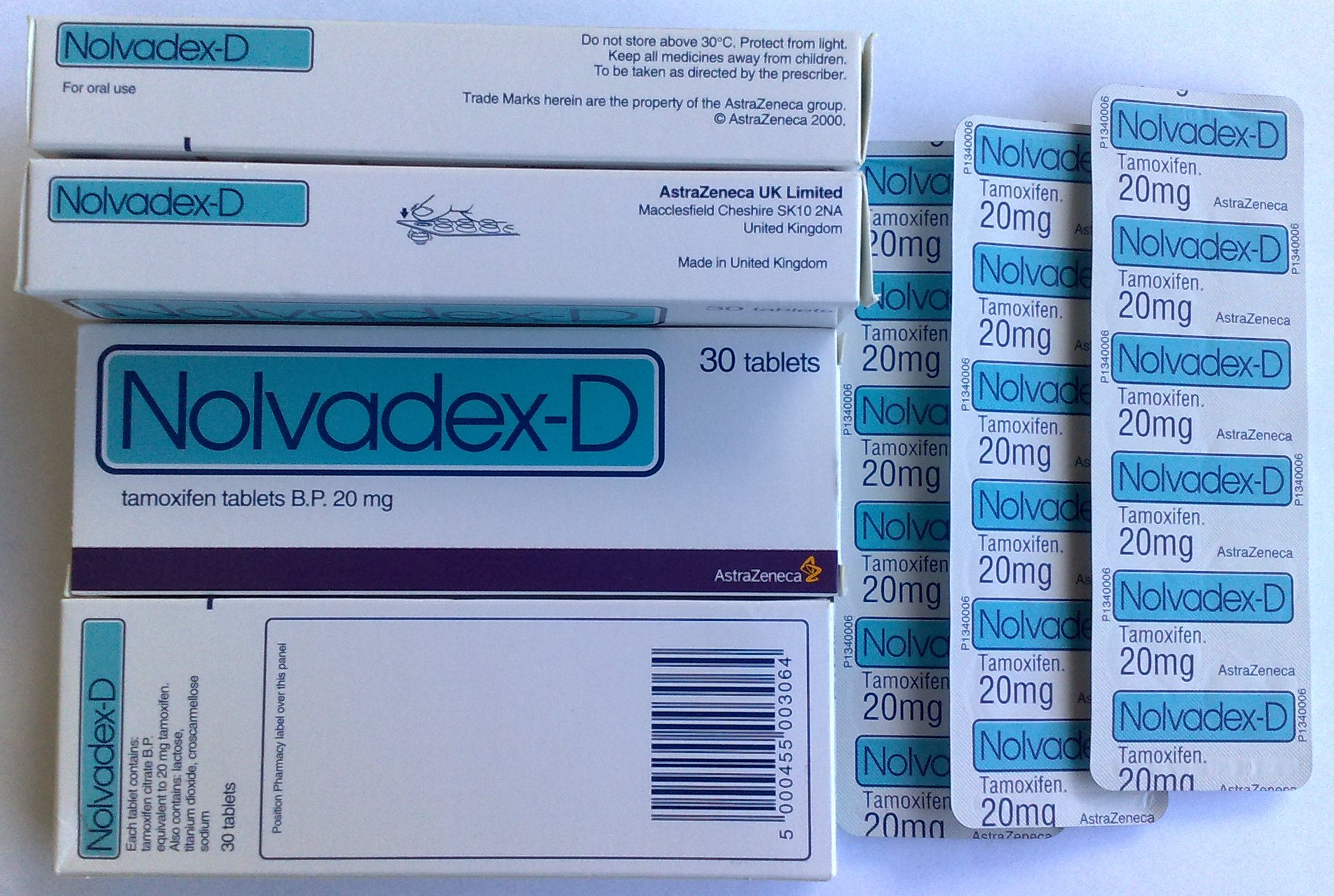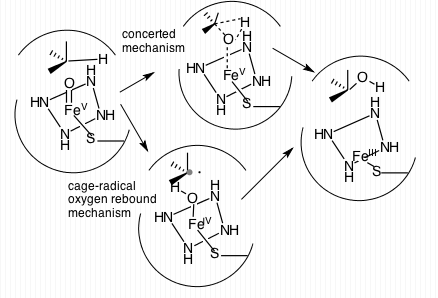|
Tamoxifen
Tamoxifen, sold under the brand name Nolvadex among others, is a selective estrogen receptor modulator used to prevent breast cancer in women and treat breast cancer in women and men. It is also being studied for other types of cancer. It has been used for Albright syndrome. Tamoxifen is typically taken daily by mouth for five years for breast cancer. Serious side effects include a small increased risk of uterine cancer, stroke, vision problems, and pulmonary embolism. Common side effects include irregular periods, weight loss, and hot flashes. It may cause harm to the baby if taken during pregnancy or breastfeeding. It is a selective estrogen-receptor modulator (SERM) and works by decreasing the growth of breast cancer cells. It is a member of the triphenylethylene group of compounds. Tamoxifen was initially made in 1962, by chemist Dora Richardson. It is on the World Health Organization's List of Essential Medicines. Tamoxifen is available as a generic medication. ... [...More Info...] [...Related Items...] OR: [Wikipedia] [Google] [Baidu] |
Selective Estrogen Receptor Modulator
Selective estrogen receptor modulators (SERMs), also known as estrogen receptor agonist/antagonists (ERAAs), are a class of drugs that act on the estrogen receptor (ER). A characteristic that distinguishes these substances from pure ER agonists and antagonists (that is, full agonists and silent antagonists) is that their action is different in various tissues, thereby granting the possibility to selectively inhibit or stimulate estrogen-like action in various tissues. Medical uses SERMs are used for various estrogen-related diseases, including treatment of ovulatory dysfunction in the management of infertility, treatment and prevention of postmenopausal osteoporosis, treatment and reduction in risk of breast cancer and treatment of dyspareunia due to menopause. SERM is also used in combination with conjugated estrogens indicated for the treatment of estrogen deficiency symptoms, and vasomotor symptoms associated with menopause. SERMs are used dependent on their pattern of ... [...More Info...] [...Related Items...] OR: [Wikipedia] [Google] [Baidu] |
Selective Estrogen-receptor Modulator
Selective estrogen receptor modulators (SERMs), also known as estrogen receptor agonist/antagonists (ERAAs), are a class of drugs that act on the estrogen receptor (ER). A characteristic that distinguishes these substances from pure ER agonists and antagonists (that is, full agonists and silent antagonists) is that their action is different in various tissues, thereby granting the possibility to selectively inhibit or stimulate estrogen-like action in various tissues. Medical uses SERMs are used for various estrogen-related diseases, including treatment of ovulatory dysfunction in the management of infertility, treatment and prevention of postmenopausal osteoporosis, treatment and reduction in risk of breast cancer and treatment of dyspareunia due to menopause. SERM is also used in combination with conjugated estrogens indicated for the treatment of estrogen deficiency symptoms, and vasomotor symptoms associated with menopause. SERMs are used dependent on their pattern of ac ... [...More Info...] [...Related Items...] OR: [Wikipedia] [Google] [Baidu] |
N-Desmethyltamoxifen
''N''-Desmethyltamoxifen (developmental code name ICI-55,548) is a major metabolite of tamoxifen, a selective estrogen receptor modulator (SERM). ''N''-Desmethyltamoxifen is further metabolized into endoxifen (4-hydroxy-''N''-desmethyltamoxifen), which is thought to be the major active form of tamoxifen in the body. In one study, ''N''-desmethyltamoxifen had an affinity for the estrogen receptor of 2.4% relative to estradiol. For comparison, tamoxifen, endoxifen, and afimoxifene Afimoxifene, also known as 4-hydroxytamoxifen (4-OHT) and by its tentative brand name TamoGel, is a selective estrogen receptor modulator (SERM) of the triphenylethylene group and an active metabolite of tamoxifen. The drug is under development u ... (4-hydroxytamoxifen) had relative binding affinities of 2.8%, 181%, and 181%, respectively. References Amines Hormonal antineoplastic drugs Human drug metabolites Prodrugs Selective estrogen receptor modulators Triphenylethylenes {{Antin ... [...More Info...] [...Related Items...] OR: [Wikipedia] [Google] [Baidu] |
N,N-Didesmethyltamoxifen
''N'',''N''-Desmethyltamoxifen is a metabolite of tamoxifen, a selective estrogen receptor modulator (SERM). It is formed from ''N''-desmethyltamoxifen and is an intermediate in the conversion of tamoxifen and ''N''-desmethyltamoxifen into norendoxifen (4-hydroxy-''N'',''N''-desmethyltamoxifen), an active metabolite An active metabolite is an active form of a drug after it has been processed by the body. Metabolites of drugs An active metabolite results when a drug is metabolized by the body into a modified form which continues to produce effects in the body ... of tamoxifen. References Amines Aromatase inhibitors Hormonal antineoplastic drugs Human drug metabolites Prodrugs Triphenylethylenes {{Antineoplastic-drug-stub ... [...More Info...] [...Related Items...] OR: [Wikipedia] [Google] [Baidu] |
Endoxifen
Endoxifen, also known as 4-hydroxy-''N''-desmethyltamoxifen, is a nonsteroidal selective estrogen receptor modulator (SERM) of the triphenylethylene group as well as a protein kinase C (PKC) inhibitor. It is under development for the treatment of estrogen receptor-positive breast cancer and for the treatment of mania in bipolar disorder. It is taken by mouth. Endoxifen is an active metabolite of tamoxifen and has been found to be effective in patients that have failed previous hormonal therapies (tamoxifen, aromatase inhibitors, and fulvestrant). The prodrug tamoxifen is metabolized by the CYP2D6 enzyme to produce endoxifen and afimoxifene (4-hydroxytamoxifen). Currently, endoxifen is approved by Drugs Controller General of India for the acute treatment of manic episode with or without mixed features of Bipolar I disorder. It is manufactured and sold by Intas Pharmaceuticals under the brand name Zonalta. Medical uses Bipolar disorder Endoxifen is used to treat manic or m ... [...More Info...] [...Related Items...] OR: [Wikipedia] [Google] [Baidu] |
Breast Cancer
Breast cancer is cancer that develops from breast tissue. Signs of breast cancer may include a lump in the breast, a change in breast shape, dimpling of the skin, milk rejection, fluid coming from the nipple, a newly inverted nipple, or a red or scaly patch of skin. In those with distant spread of the disease, there may be bone pain, swollen lymph nodes, shortness of breath, or yellow skin. Risk factors for developing breast cancer include obesity, a lack of physical exercise, alcoholism, hormone replacement therapy during menopause, ionizing radiation, an early age at first menstruation, having children late in life or not at all, older age, having a prior history of breast cancer, and a family history of breast cancer. About 5–10% of cases are the result of a genetic predisposition inherited from a person's parents, including BRCA1 and BRCA2 among others. Breast cancer most commonly develops in cells from the lining of milk ducts and the lobules that supp ... [...More Info...] [...Related Items...] OR: [Wikipedia] [Google] [Baidu] |
Norendoxifen
Norendoxifen, also known as 4-hydroxy-''N'',''N''-didesmethyltamoxifen, is a nonsteroidal aromatase inhibitor (AI) of the triphenylethylene group that was never marketed. It is an active metabolite of the selective estrogen receptor modulator (SERM) tamoxifen. Unlike tamoxifen, norendoxifen is not a SERM, and instead has been found to act as a potent and selective competitive inhibitor of aromatase (''K''i = 35 nM). Drugs with dual SERM and AI activity, such as 4'-hydroxynorendoxifen, have been developed from norendoxifen, and may have therapeutic potential as antiestrogens in the treatment of estrogen receptor-positive breast cancer. See also * Afimoxifene Afimoxifene, also known as 4-hydroxytamoxifen (4-OHT) and by its tentative brand name TamoGel, is a selective estrogen receptor modulator (SERM) of the triphenylethylene group and an active metabolite of tamoxifen. The drug is under development u ... (4-hydroxytamoxifen) * Endoxifen (4-hydroxy-''N''-desmethyltamoxif ... [...More Info...] [...Related Items...] OR: [Wikipedia] [Google] [Baidu] |
Afimoxifene
Afimoxifene, also known as 4-hydroxytamoxifen (4-OHT) and by its tentative brand name TamoGel, is a selective estrogen receptor modulator (SERM) of the triphenylethylene group and an active metabolite of tamoxifen. The drug is under development under the tentative brand name TamoGel as a topical gel for the treatment of hyperplasia of the breast. It has completed a phase II clinical trial for cyclical mastalgia, but further studies are required before afimoxifene can be approved for this indication and marketed. Afimoxifene is a SERM and hence acts as a tissue-selective agonist–antagonist of the estrogen receptors ERα and ERβ with mixed estrogenic and antiestrogenic activity depending on the tissue. It is also an agonist of the G protein-coupled estrogen receptor (GPER) with relatively low affinity (100–1,000 nM, relative to 3–6 nM for estradiol Estradiol (E2), also spelled oestradiol, is an estrogen steroid hormone and the major female sex hormone ... [...More Info...] [...Related Items...] OR: [Wikipedia] [Google] [Baidu] |
CYP2D6
Cytochrome P450 2D6 (CYP2D6) is an enzyme that in humans is encoded by the ''CYP2D6'' gene. ''CYP2D6'' is primarily expressed in the liver. It is also highly expressed in areas of the central nervous system, including the substantia nigra. CYP2D6, a member of the cytochrome P450 mixed-function oxidase system, is one of the most important enzymes involved in the metabolism of xenobiotics in the body. In particular, CYP2D6 is responsible for the metabolism and elimination of approximately 25% of clinically used drugs, via the addition or removal of certain functional groups – specifically, hydroxylation, demethylation, and dealkylation. CYP2D6 also activates some prodrugs. This enzyme also metabolizes several endogenous substances, such as hydroxytryptamines, neurosteroids, and both ''m''-tyramine and ''p''-tyramine which CYP2D6 metabolizes into dopamine in the brain and liver. Considerable variation exists in the efficiency and amount of CYP2D6 enzyme produced be ... [...More Info...] [...Related Items...] OR: [Wikipedia] [Google] [Baidu] |
Triphenylethylene
Triphenylethylene (TPE) is a simple aromatic hydrocarbon that possesses weak estrogenic activity. Its estrogenic effects were discovered in 1937. TPE was derived from structural modification of the more potent estrogen diethylstilbestrol, which is a member of the stilbestrol group of nonsteroidal estrogens. TPE is the parent compound of a group of nonsteroidal estrogen receptor ligands. It includes the estrogens chlorotrianisene, desmethylchlorotrianisene, estrobin (DBE), M2613, triphenylbromoethylene, triphenylchloroethylene, triphenyliodoethylene, triphenylmethylethylene; the selective estrogen receptor modulators (SERMs) afimoxifene, brilanestrant, broparestrol, clomifene, clomifenoxide, droloxifene, endoxifen, etacstil, fispemifene, idoxifene, miproxifene, miproxifene phosphate, nafoxidine, ospemifene, panomifene, and toremifene. The antiestrogen ethamoxytriphetol (MER-25) is also closely related, but is technically not a derivative of TPE and is instead ... [...More Info...] [...Related Items...] OR: [Wikipedia] [Google] [Baidu] |
CYP3A4
Cytochrome P450 3A4 (abbreviated CYP3A4) () is an important enzyme in the body, mainly found in the liver and in the intestine. It oxidizes small foreign organic molecules ( xenobiotics), such as toxins or drugs, so that they can be removed from the body. It is highly homologous to CYP3A5, another important CYP3A enzyme. While many drugs are deactivated by CYP3A4, there are also some drugs which are ''activated'' by the enzyme. Some substances, such as some drugs and furanocoumarins present in grapefruit juice, interfere with the action of CYP3A4. These substances will therefore either amplify or weaken the action of those drugs that are modified by CYP3A4. CYP3A4 is a member of the cytochrome P450 family of oxidizing enzymes. Several other members of this family are also involved in drug metabolism, but CYP3A4 is the most common and the most versatile one. Like all members of this family, it is a hemoprotein, i.e. a protein containing a heme group with an iron atom. In humans, ... [...More Info...] [...Related Items...] OR: [Wikipedia] [Google] [Baidu] |




